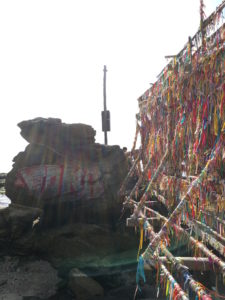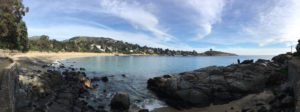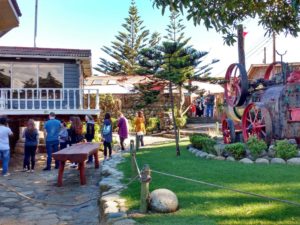After the first week of adaptation, I became much more confident talking in Spanish and more comfortable living as a Chilean. Through either daily class or my host family, I observed, experienced and have learnt a lot about the local’s culture and their lifestyle. Like most of the local people, I always take the public transportation for school, such as “metro”, “micro” and “colectivo”. Among them, I really enjoy taking the “metro” since it gives me the chance to look at the city closely by myself and get involved with different groups of Chilean people. Through the window of the train, I watched the sunrise from the end of the extremely blue ocean every morning, saw the young couples kissing sweetly on the bridge, and viewed several people with bright uniforms running along the coastline. On the train, I listened to the folk songs played by the busker, played with the little kids travelling with their mother, and sometimes bought a snack from those low-income people. I began to notice the distinct social classes within society and how various people make a life.
Furthermore, this weekend we spent both Saturday and Sunday on two different excursions near Viña del Mar and Valparaíso. On Saturday, we did a full-day trip visiting the “playas del norte” in order to appreciate the beaches that make up the country’s coastline. Firstly, we stopped at a couple of spots in Concón to see the beautiful sand dunes and diverse rock formations along the coastline. Then, we moved forward to Horcón, which is predominantly a coastal village of fishermen and artisans. Here we saw a bunch of small restaurants and souvenir shops that represent a more traditional type of Chilean family—getting along by fishing in the ocean and making or selling some small handicrafts. The prevalence of the sea and the fishing industry are strongly performed in this area. The locals all keep the simplest lifestyle. We even saw a bridge to the sea for the locals to make wishes and worship the power of the sea. Lastly, we went to the exclusive seaside resort Zapallar, which shows an opposite side of Horcón. Zapallar lives the people from the top economic and social class in Chile. All of the houses and streets are carefully decorated with pretty stones and plants, and there is no stray dog anywhere in this area. The beautiful beach here is only for people to relax and have fun in the ocean.
On Sunday, we visited Isla Negra and the most popular house of Pablo Neruda on it. This time, we saw another aspect of the country—the literary part. The special geographical feature of the long coastline on one side and continuous hills on the other side not only boasts the fishing industry, but also offers a lot of inspiration for creative work, like the poetry, the painting and even the graffiti on the streets. All of these different aspects make Chile a distinctive country in the world and give me more reasons to learn more about this country!



